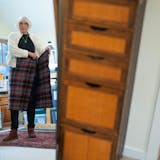Richfield High School students had a litany of questions for Minnesota Supreme Court justices Tuesday morning: How do they respond to public criticism of their work? How do they decide cases they might personally disagree with?
But freshman Niya Briggs had a big career question, plus a dash of fashion critique, for Associate Justice Natalie Hudson.
"My question is for the lady in pink — gorgeous, by the way — I'm just wondering how you guys get into this sort of thing?" Briggs asked as the auditorium broke out in laughter.
The scene played out as part of the Supreme Court's annual roadshow. The court has listened to oral arguments in high schools across the state for decades; this time, justices took up a school segregation case — Cruz-Guzman v. State of Minnesota — that could lead to the largest reorganization of Minnesota schools in decades.
The justices said they typically ask court staff to consult with school district officials to find cases that might interest students. The litigation isn't always related to education, but in this case it was a happy coincidence, Chief Justice Lorie Skjerven Gildea said.
Hundreds of students watched in the auditorium as lawyers for both sides stated their case and justices questioned them about their positions. Associate Justice Gordon Moore said it was important for the teens to see the rigorous questioning of both sides.
But student Brody Titzer was curious: How do justices decide cases when their personal beliefs conflict with the letter of the law?
Hudson said she's written court opinions with which she didn't personally agree. But she signed on to them because the court interprets the law — its members don't act on their individual beliefs.


